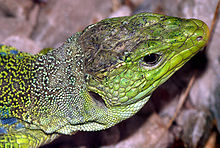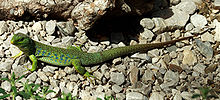Pearl lizard
| Pearl lizard | ||||||||||||
|---|---|---|---|---|---|---|---|---|---|---|---|---|

Pearl lizard ( timon lepidus ) |
||||||||||||
| Systematics | ||||||||||||
|
||||||||||||
| Scientific name | ||||||||||||
| Timon lepidus | ||||||||||||
| ( Daudin , 1802) |
The pearl lizard ( Timon lepidus ) is the largest European lizard and belongs to the genus Timon within the family of real lizards (Lacertidae) . Until a few years ago the species was still listed in the genus Lacerta .
distribution
The pearl lizard occurs on the entire Iberian Peninsula with the exception of the northern Spanish Bay of Biscay coast and the higher Pyrenees , in southern France ( Aquitaine , Languedoc-Roussillon , Rhone Valley , Provence ) and in the extreme northwest of Italy . It lives mainly on dry and sandy to stony biotopes, including cultural landscapes such as vineyards. In the mountains it can be found up to heights of 2100 meters.
description
The pearl lizard reaches a length of 60 to 65 centimeters, in exceptional cases even 90 centimeters, and is of a strong, compact shape. The tail is 1.5 to 2 times as long as the body. The bumpy, pearl-shaped scales give the pearl lizard its name. The back and flanks are green, rarely gray or brownish in color and streaked with a net-like pattern. Blue spots with a black border can be seen on the flanks. The ventral side is yellowish to cream-colored, less often greenish. The males in particular have a powerful head with a swollen cheek region. The tail is thick at the root but tapering to a point. Young animals are green and have numerous yellow or whitish, black-rimmed spots on the upper side.
Way of life
Pearl lizards are very hungry for the sun, especially in early March and again in October before the hibernation . In summer, when temperatures are high enough, sunbathing tends to be restricted. Pearl lizards dig an underground burrow to protect themselves from enemies and to sleep in, move into a rodent burrow or hide in piles of rubble or in hollow tree trunks. On the run, they can run very quickly with their bodies and tails raised slightly above the ground. The natural enemies of the pearl lizard include the European lizard snake , the booted eagle , the hawk and the two kite species . Endangered animals snarle and even jump at the enemy. Pearl lizards are quite controversial and bitterly defend their territory from other species.
food
The pearl lizard lives mainly on animal food such as larger insects ( beetles , grasshoppers , crickets ), snails , but also on defensive and bad-tasting invertebrates such as scorpions and scolopers . In addition, they occasionally eat overripe sweet fruits and small vertebrates.
Reproduction
Male pearl lizards are sexually mature at two, females at three years of age . The mating season begins shortly after hibernation. Males determine that the females are ready to mate by licking the cloaca. The female digs a pit in the sandy soil and lays up to 20 eggs in the hollow. After the eggs have been laid, the nest is carefully covered with sand. After about three months, the young lizards hatch, which have a hatching length of 10.5 to 12 centimeters.
Subspecies
- Timon lepidus ibericus ( López-Seoane , 1884)
- Timon lepidus lepidus ( Daudin , 1802)
- Timon lepidus nevadensis ( Buchholz , 1963)
- Timon lepidus oteroorum ( Castroviejo & Mateo , 1998)
literature
- Günter Diesener, Josef Reichholf : amphibians and reptiles (= Steinbach's natural guide. ). Mosaik-Verlag, Munich 1996, ISBN 3-576-10697-9 .
- Manfred Rogner : Lizards. Volume 2: Monitor lizards, skinks and other lizards as well as bridge lizards and crocodiles. Ulmer, Stuttgart 1994, ISBN 3-8001-7253-4 .
Web links
- Timon lepidus in The Reptile Database
- The pearl lizard on www.lacerta.de
- More photos of the pearl lizard
- Biotropics.com
- Photos of the pearl lizard on www.herp.it
- Timon lepidus inthe IUCN 2013 Red List of Threatened Species . Posted by: Juan M. Pleguezuelos, Paulo Sá-Sousa, Valentin Pérez-Mellado, Rafael Marquez, Marc Cheylan, Claudia Corti, Iñigo Martínez-Solano, 2008. Retrieved January 30, 2014.



